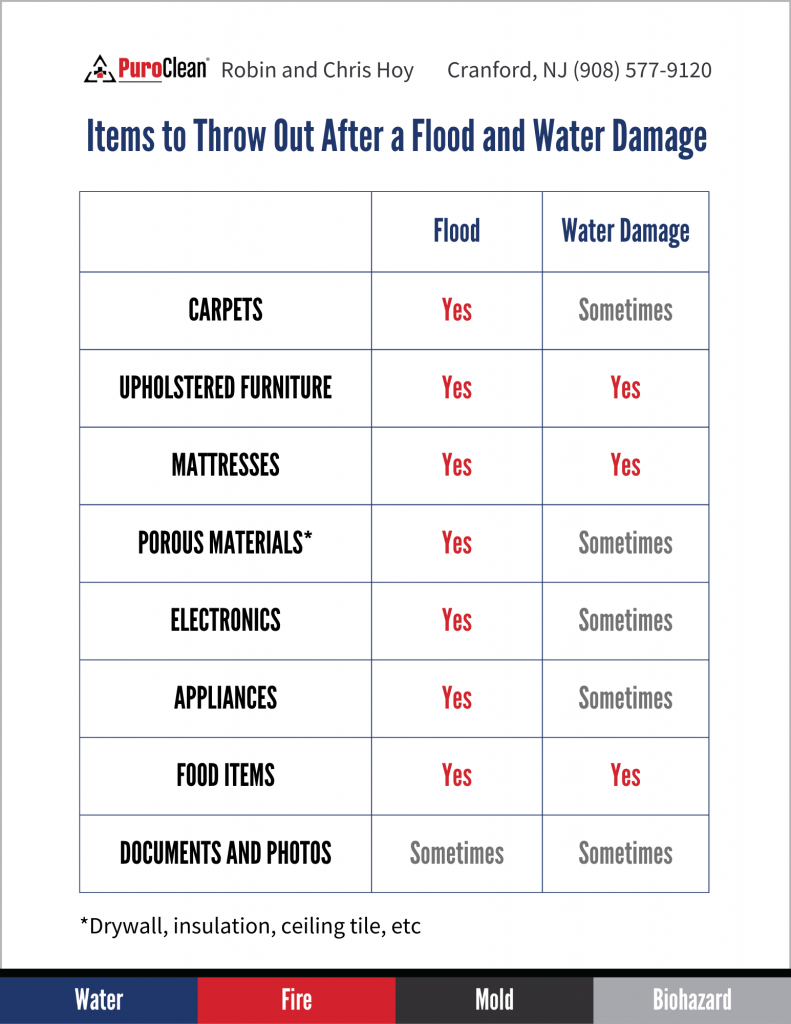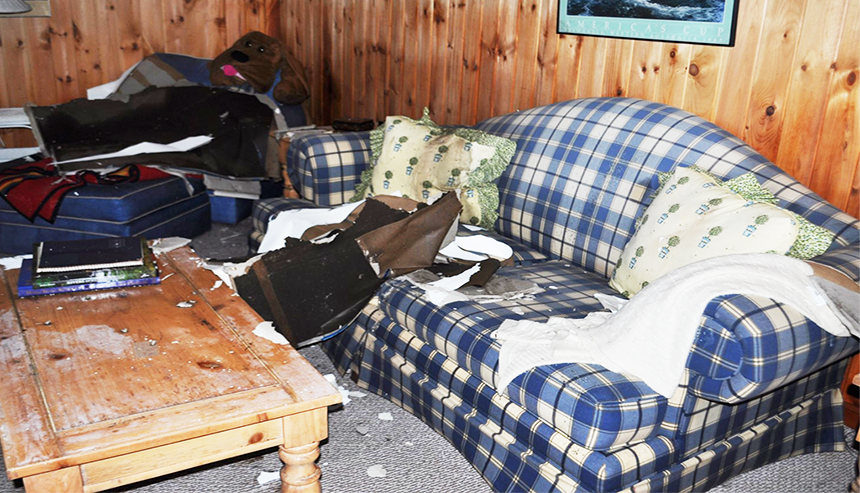Navigating the Aftermath: What to Keep and What to Toss After a Flood
You just had a flood. The floodwaters have receded, but the real challenge has just begun. As you survey your home, you’re faced with a daunting task.
You need to decide what to save and what to throw out. It’s not just about cleaning your possessions. It’s about protecting your health and home from hidden dangers. Read on to learn what to throw out after a flood to stay safe.
Quick Article Links:

The Hidden Risks: Mold, Bacteria and Chemicals
Waterlogged items often harbor unseen hazards:
- Mold spores, ready to bloom in damp environments
- Bacteria that thrive in standing water
- Harmful chemicals that may have seeped into porous materials
These silent invaders pose serious health risks if not addressed promptly and properly.
Your Path Forward, Saving Home and Health
With a systematic approach, you can:
- Protect your health and the health of your loved ones
- Salvage what’s safe and valuable
- Facilitate a smooth rebuilding process
Allowing things to dry properly is crucial to prevent damage and mold growth. Use fans to enhance air circulation and reduce the time needed for various materials, such as wood floors and savable furniture.
This guide will help you decide what to keep, what to discard, and how to move forward and recover from the water damage. By following this expert advice, you can turn this setback into an opportunity for renewal.
Stop Mold Growth Before It Starts
Mold is a serious concern after flooding, as spores can begin to spread within 48 hours of water exposure. If left unchecked, mold can pose significant health risks plus cause structural damage to your home. Addressing floods and standing water quickly is essential to prevent these mold dangers from escalating.
Flooded areas are particularly vulnerable to mold, mildew, and other contaminants. As floodwaters recede, the lingering moisture creates an ideal mold environment.
Early detection and remediation are key to avoiding damage and maintaining a healthy home. Promptly drying affected areas and removing contaminated materials can reduce the risk of mold.
Critical Things to Throw Away After a Flood
Water contamination level and exposure time affect an item’s fate. They determine if it can be restored or must be thrown away.
Depending on the conditions, like how long the water has been standing, gray water can become dangerous blackwater. This potential change increases the urgency for proper cleanup and disposal.
Household items exposed to contaminated floodwaters, like carpets, upholstered furniture, and stuffed animals, must be discarded to prevent health hazards.
Food and Medications
- Discard food items and beverages exposed to floodwater. This includes perishables and non-perishables with damaged packaging. This also includes canned items with damaged or swollen cans. They can harbor harmful bacteria. Throw out any items not sealed in waterproof or non-porous containers with water-tight lids.
- Be cautious with home-canned goods. Most guidelines recommend throwing out all home-canned goods exposed to floodwater.
- If a power outage occurs, check the food in the refrigerator. If the refrigerator’s temperature rises above 40°F for more than two hours, some foods can spoil. Spoiled food can grow bacteria like E. coli and Salmonella. If eaten, they can cause foodborne illnesses. It’s vital to discard perishable foods, like meat and dairy. If stored at unsafe temperatures, they can cause food poisoning.
- Items that come in contact with food, like wooden cutting boards and wooden spoons, baby bottles and pacifiers, must be thrown away. You can clean things like cutlery, plates and glasses. The Centers for Disease Control says to use a solution of clean, hot water and soap. Rinse well with clean water, then sanitize them with a solution of bleach and water. (See link for specifics.)
- Throw out any medicines that touched floodwater. They may be contaminated, especially if not in water-resistant containers.
- Cosmetics also need to be thrown away.
Upholstered Furniture and Mattresses
Upholstered sofas, chairs, and mattresses soaked with floodwater are unsafe and must be thrown out. Once soaked with contaminated water, upholstery is a health risk. They are nearly impossible to restore to a safe condition.
Due to the challenges in thoroughly cleaning and sanitizing these materials, disposal is the safest option.
Carpeting and Carpet Pads (Sometimes)
- If floodwater has hit your carpet and pad, assess the situation. Most often, these items will need to be tossed.
- However, most carpet pads have a vapor barrier—a plastic layer that prevents them from drying out properly. For clean water exposure, lift and dry the carpet. Then, replace the pad. This can save you the cost of replacing the carpet. A water remediation professional will suggest the proper course of action for your particular situation. However, remove the carpet and pad if the flooding involves sewage (a sewer loss).
Drywall and Insulation
Porous items can harbor mold if not cleaned and dried quickly. To prevent health hazards, throw away materials like drywall, insulation, and other absorbent materials to prevent health hazards.
Mold can form on sheetrock, especially in basements around base moldings, trim, or ceiling joists.
- Pro Tip: Cutting sheetrock and raising trim around the basement floor can mitigate moisture damage. Sheetrock should not be installed touching the basement floor to allow for expansion and moisture damage. You can cut the sheetrock and put up higher trim around the basement floor.
Particleboard Furniture
Particleboard furniture is susceptible to damage when exposed to floodwater. Wet particleboard furniture often loses its strength. Due to the loss of integrity, any wet particleboard items, like cabinets and shelves, should be tossed out.
Warped Furniture
Warped Pieces, especially those made of wood, are a common casualty after a flood. Water absorption can cause wood to swell and warp, making it unstable. The warping makes it unsafe to use and difficult to repair. Also, the moisture can encourage mold growth.
What Can Be Cleaned
Synthetic materials generally have a higher chance of being salvaged after flood exposure. Non-porous surfaces should be scrubbed with a strong cleaner and very hot water.
Undamaged canned goods can be saved if appropriately cleaned. Just be sure to discard those with leaks, dents, or bulges.
Hard Surfaces and Non-Porous Items
Non-porous items can often be cleaned using hot water combined with disinfectants. Cleaning non-porous surfaces prevents contamination and ensures a safer environment post-flood.
Appliances and Electronics
It may be possible to save appliances and electronics. It depends on how much water they were exposed to. Carefully check each appliance. Consult with professionals if needed. Proper clean-and-dry methods can sometimes restore these things. But your welfare should always come first.
Documents and Photos (Sometimes)
For documents and photos, act quickly. Toss items with mold or severe water damage. Air drying or professional restoration may help with slightly damaged documents and pictures.
Safety Precautions During the Cleanup Process
Floodwaters harbor harmful bacteria and pathogens, making precautions critical during cleanup. Cleanup workers should wear proper personal protective equipment (PPE). Also, ensure good ventilation and proper cleaning techniques.
Immediate Steps – After a flood, ensuring the area’s integrity is the first step before any cleanup efforts. One of the first steps is to turn off the electricity, even if power is out in the neighborhood. Floodwaters can cause electrical systems to short-circuit or create dangerous situations if the power is restored while the area is still wet.
Avoid the area and contact a professional or utility company if you need help turning off your electricity safely. If the flood damage is related to a water main break or other exterior line break, notify local authorities or the water company.
- Wear Protective Clothing and Gear: Wear waterproof boots, rubber gloves, and goggles when handling contaminated water. This will help ensure your safety. Wearing a mask (an N95 respirator or better) during flood damage cleanup helps filter mold spores and bacteria.
- Use Cleaning Products Safely: When using cleaning agents like bleach, follow the guidelines on the label. This ensures effective disinfection and reduces risks.
Mixing household cleaning products may cause harmful and even potentially lethal reactions. Do not mix bleach with other products. Wear PPE and provide good ventilation to reduce inhalation risks from chemicals.
How to Document Flood Damage for Insurance Claims
Documenting flood damage supports your insurance claim.
Take Photos and Videos
Photograph and videotape all items and damaged areas from multiple angles before removing them from the property to create thorough documentation. Taking clear visual evidence before starting the cleanup process ensures an easier insurance claim process.
Contacting Your Insurance Agent
Contact your insurance professional right away. Start the insurance claims process and check your coverage. Including serial numbers and keeping receipts enhances the documentation process for insurance purposes.
Be sure you understand the replacement cost section of your home insurance policy. It impacts the reimbursement for damaged or lost personal property. Knowing how your coverage works helps you make informed decisions on what to discard.
When to Call a Professional Cleaning and Restoration Company
Flood recovery starts now. Create your checklist of what to discard and document the damage for your insurance claim.
Need help? Contact PuroClean of Craford today for immediate, professional assistance. Call us at (908) 577-9120.
At PuroClean, we understand the stress of water damage. It can create a sense of urgency to fix your home or business. Our trained, background-checked IICRC water remediation, mold remediation, and damage restoration technicians can help 24/7. Don’t delay! Protect your home and health now.




 PuroClean Restoration Services
PuroClean Restoration Services